INTERNATIONAL TELECOMMUNICATION UNION
)45
4
TELECOMMUNICATION
STANDARDIZATION SECTOR
OF ITU
4
(11/94)
4%2-).!,3��&/2��4%,%-!4)#��3%26)#%3
).&/2-!4)/.��4%#(./,/’9�
$)’)4!,��#/-02%33)/.��!.$��#/$).’
/&��#/.4).5/53
4/.%��34),,��)-!’%3
#/-0,)!.#%��4%34).’
)45
4��2ECOMMENDATION��4
(Previously “CCITT Recommendation”)
�
Foreword
ITU (International Telecommunication Union)
the field of
telecommunications. The ITU Telecommunication Standardization Sector (ITU-T) is a permanent organ of the ITU.
Some 179 member countries, 84 telecom operating entities, 145 scientific and industrial organizations and
38 international organizations participate in ITU-T which is the body which sets world telecommunications standards
(Recommendations).
the United Nations Specialized Agency
is
in
The approval of Recommendations by the Members of ITU-T is covered by the procedure laid down in WTSC
Resolution No. 1 (Helsinki, 1993). In addition, the World Telecommunication Standardization Conference (WTSC),
which meets every four years, approves Recommendations submitted to it and establishes the study programme for the
following period.
In some areas of information technology which fall within ITU-T’s purview, the necessary standards are prepared on a
collaborative basis with ISO and IEC. The text of ITU-T Recommendation T.83 was approved on 11th of November
1994. The identical text is also published as ISO/IEC International Standard 10918-2.
___________________
In this Recommendation, the expression “Administration” is used for conciseness to indicate both a telecommunication
administration and a recognized operating agency.
NOTE
All rights reserved. No part of this publication may be reproduced or utilized in any form or by any means, electronic or
mechanical, including photocopying and microfilm, without permission in writing from the ITU.
ITU 1995
ª
�
CONTENTS
Summary....................................................................................................................................................................
Introduction ...............................................................................................................................................................
Scope..............................................................................................................................................................
1
Normative references .....................................................................................................................................
2
3
Definitions, abbreviations, symbols, and conventions ...................................................................................
General ...........................................................................................................................................................
4
Compressed data format compliance testing..................................................................................................
5
6
Encoder compliance tests ...............................................................................................................................
7
Decoder compliance tests...............................................................................................................................
Annex A – Procedures for determining generic encoder and decoder compliance ...................................................
Annex B – Quantization tables for generic compliance testing of DCT-based processes.........................................
Annex C – Compressed test data stream structure for generic decoder compliance tests .........................................
Annex D – Construction of application-specific compliance tests............................................................................
Annex E – Compliance test data for testing of greater computational accuracy .......................................................
Annex F – Specification of supported parameter ranges...........................................................................................
Annex H – Examples and guidelines.........................................................................................................................
Page
ii
ii
1
1
1
4
6
19
20
25
28
30
51
53
55
58
ITU-T Rec. T.83 (1994 E)
i
�
Summary
This Recommendation | International Standard, Digital Compression and Coding of Continuous-tone Still Images, is
published as two parts:
ITU-T Rec. T.81 | ISO/IEC 10918-1 “Requirements and guidelines” sets out requirements and implementation
guidelines for continuous-tone still image encoding and decoding processes, and for the coded representation of
compressed image data. These processes and representations are intended to be generic, that is, to be applicable to a
broad range of applications for colour and grayscale still images within communications and computer systems.
This part, ITU-T Rec. T.83 | ISO/IEC 10918-2 “Compliance testing” sets out tests for determining whether
implementations comply with the requirements for the various encoding and decoding processes specified in ITU-T
Rec. T.81 | ISO/IEC 10918-1. ITU-T Rec. T.83 | ISO/IEC 10918-2 also specifies tests for determining whether any
specific instance of compressed data complies with the ITU-T Rec. T.81 | ISO/IEC 10918-1 specification for compressed
data format.
Introduction
This Recommendation | International Standard, Digital Compression and Coding of Continuous-tone Still Images, is
published as two parts:
–
–
ITU-T Rec. T.81 | ISO/IEC 10918-1: Requirements and guidelines.
ITU-T Rec. T.83 | ISO/IEC 10918-2: Compliance testing.
ITU-T Rec. T.81 | ISO/IEC 10918-1 sets out requirements and implementation guidelines for continuous-tone still image
encoding and decoding processes, and for the coded representation of compressed image data. These processes and
representations are intended to be generic, that is, to be applicable to a broad range of applications for colour and
grayscale still images within communications and computer systems.
This part, ITU-T Rec. T.83 | ISO/IEC 10918-2, sets out tests for determining whether implementations comply with the
requirements for the various encoding and decoding processes specified in ITU-T Rec. T.81 | ISO/IEC 10918-1. ITU-T
Rec. T.83 | ISO/IEC 10918-2 also specifies tests for determining whether any specific instance of compressed data
complies with the ITU-T Rec. T.81 | ISO/IEC 10918-1 specification for compressed data format.
The committee which has prepared this Specification is the ISO/IEC JTC1/SC29/WG1 Sub Group on JPEG, also known
as the Joint Photographic Experts Group (JPEG). Both the committee and the two parts of this Specification continue to
be known informally by the name JPEG.
The “joint” in JPEG refers to the committee’s collaboration with the ITU-T SG8 Rapporteur’s Group on
Recommendation Q.16. In this collaboration, WG1 has performed the work of selecting, developing, documenting, and
testing the generic compression processes.
ITU-T SG8 has provided the requirements which these processes must satisfy to be useful for specific image
communications applications such as facsimile, videotex, and audiographic conferencing.
This Specification is presented in accordance with the rules of ITU-T and ISO/IEC JTC1 established by “Rules for
presentation of ITU-T | ISO/IEC common text”.
Annexes A, B, C, and D form an integral part of this Specification. Annexes E, F, G, and H are for information only.
ii
ITU-T Rec. T.83 (1994 E)
�
INTERNATIONAL STANDARD
ISO/IEC 10918-2 : 1995 (E)
ITU-T Rec. T.83 (1994 E)
ITU-T RECOMMENDATION
ISO/IEC 10918-2 : 1995 (E)
INFORMATION TECHNOLOGY – DIGITAL COMPRESSION AND CODING OF
CONTINUOUS-TONE STILL IMAGES: COMPLIANCE TESTING
1
Scope
This Recommendation | International Standard is concerned with compliance tests for the continuous-tone still image
encoding processes, decoding processes, and compressed data formats specified in ITU-T Rec. T.81 | ISO/IEC 10918-1.
This Specification:
–
–
–
–
–
specifies compliance tests for the ITU-T Rec. T.81 | ISO/IEC 10918-1 compressed data formats;
specifies compliance tests for the ITU-T Rec. T.81 | ISO/IEC 10918-1 encoding processes;
specifies compliance tests for the ITU-T Rec. T.81 | ISO/IEC 10918-1 decoding processes;
specifies a method for constructing application-specific compliance tests;
gives guidance and examples on how to implement these tests in practice.
This Specification specifies normative generic compliance tests for the ITU-T Rec. T.81 | ISO/IEC 10918-1 encoding
and decoding processes. These compliance tests are applicable to “stand-alone” generic implementations of one or more
of the encoding and decoding processes specified in ITU-T Rec. T.81 | ISO/IEC 10918-1. Among the purposes of these
tests is to ensure that generic encoder (and decoder) implementations compute the discrete cosine transform (DCT) and
quantization functions with sufficient accuracy.
2
Normative references
The following ITU-T Recommendations and International Standards contain provisions which, through reference in this
text, constitute provisions of this Recommendation | International Standard. At the time of publication, the editions
indicated were valid. All Recommendations and Standards are subject to revision, and parties to agreements based on
this Recommendation | International Standard are encouraged to investigate the possibility of applying the most recent
editions of the Recommendations and Standards indicated below. Members of IEC and ISO maintain registers of
currently valid International Standards. The Telecommunication Standardization Bureau of the ITU-T maintains a list of
the currently valid ITU-T Recommendations.
2.1
Additional references
–
ISO 5807:1985, Information processing – Documentation symbols and conventions for data, program
and system flowcharts, program network charts and system resources charts.
3
Definitions, abbreviations, symbols, and conventions
3.1
Definitions
For the purposes of this Specification, the following definitions apply.
3.1.1
3.1.2
3.1.3
3.1.4
(coding) process 1: Coding process with baseline sequential DCT, 8-bit sample precision.
(coding) process 2: Coding process with extended sequential DCT, Huffman coding, 8-bit sample precision.
(coding) process 3: Coding process with extended sequential DCT, arithmetic coding, 8-bit sample precision.
(coding) process 4: Coding process with extended sequential DCT, Huffman coding, 12-bit sample precision.
ITU-T Rec. T.83 (1994 E)
1
�
ISO/IEC 10918-2 : 1995 (E)
3.1.5
3.1.6
3.1.7
3.1.8
3.1.9
(coding) process 5: Coding process with extended sequential DCT, arithmetic coding, 12-bit sample precision.
(coding) process 6: Coding process with spectral selection only, Huffman coding, 8-bit sample precision.
(coding) process 7: Coding process with spectral selection only, arithmetic coding, 8-bit sample precision.
(coding) process 8: Coding process with spectral selection only, Huffman coding, 12-bit sample precision.
(coding) process 9: Coding process with spectral selection only, arithmetic coding, 12-bit sample precision.
3.1.10
(coding) process 10: Coding process with full progression, Huffman coding, 8-bit sample precision.
3.1.11
(coding) process 11: Coding process with full progression, arithmetic coding, 8-bit sample precision.
3.1.12
(coding) process 12: Coding process with full progression, Huffman coding, 12-bit sample precision.
3.1.13
(coding) process 13: Coding process with full progression, arithmetic coding, 12-bit sample precision.
3.1.14
(coding) process 14: Coding process with lossless, Huffman coding, 2- through 16-bit sample precision.
3.1.15
(coding) process 15: Coding process with lossless, arithmetic coding, 2- through 16-bit sample precision.
3.1.16
in hierarchical mode.
(coding) process 16: Coding process with extended sequential DCT, Huffman coding, 8-bit sample precision
3.1.17
in hierarchical mode.
(coding) process 17: Coding process with extended sequential DCT, arithmetic coding, 8-bit sample precision
3.1.18
in hierarchical mode.
(coding) process 18: Coding process with extended sequential DCT, Huffman coding, 12-bit sample precision
3.1.19
precision in hierarchical mode.
(coding) process 19: Coding process with extended sequential DCT, arithmetic coding, 12-bit sample
3.1.20
hierarchical mode.
(coding) process 20: Coding process with spectral selection only, Huffman coding, 8-bit sample precision in
3.1.21
hierarchical mode.
(coding) process 21: Coding process with spectral selection only, arithmetic coding, 8-bit sample precision in
3.1.22
hierarchical mode.
(coding) process 22: Coding process with spectral selection only, Huffman coding, 12-bit sample precision in
3.1.23
in hierarchical mode.
(coding) process 23: Coding process with spectral selection only, arithmetic coding, 12-bit sample precision
3.1.24
hierarchical mode.
(coding) process 24: Coding process with full progression, Huffman coding, 8-bit sample precision in
3.1.25
hierarchical mode.
(coding) process 25: Coding process with full progression, arithmetic coding, 8-bit sample precision in
3.1.26
hierarchical mode.
(coding) process 26: Coding process with full progression, Huffman coding, 12-bit sample precision in
3.1.27
hierarchical mode.
(coding) process 27: Coding process with full progression, arithmetic coding, 12-bit sample precision in
3.1.28
hierarchical mode.
(coding) process 28: Coding process with lossless, Huffman coding, 2- through 16-bit sample precision in
3.1.29
hierarchical mode.
(coding) process 29: Coding process with lossless, arithmetic coding, 2- through 16-bit sample precision in
compliance test: The procedures specified in this Specification which determine whether or not an
3.1.30
embodiment of an encoding process, compressed data stream, or decoding process complies with ITU-T Rec. T.81 |
ISO/IEC 10918-1.
3.1.31
(Distributed as part of the compliance test data.)
compressed image test data (stream): Compressed image data generated to test a particular coding process.
2
ITU-T Rec. T.83 (1994 E)
�
ISO/IEC 10918-2 : 1995 (E)
3.1.32
coding process. (Distributed as part of the compliance test data.)
compressed image validation data (stream): Compressed image data generated for validation of a particular
3.1.33
compressed test data (stream): Either compressed image test data or table specification test data or both.
3.1.34
decoder reference test data: Quantized DCT coefficient data generated by the reference FDCT and reference
quantizer from the reconstructed image data output by the reference decoder, the input to which is the compressed image
test data to be used in the DCT-based decoder compliance tests. The format of the quantized DCT coefficient data is a
file for each component; each component is a two dimensional array of 8 ·
8 blocks stored left-to-right, top-to-bottom
order; each 8 ·
8 block has 64 coefficients stored in zigzag order; and each coefficient is represented by two bytes, the
most significant byte first. This data includes the blocks which are padded to complete an MCU on the right and bottom
of the image. (Distributed as part of the compliance test data.)
3.1.35
encoder reference test data: Quantized DCT coefficient data generated by the reference FDCT and reference
quantizer from the source image test data to be used in the DCT-based encoder compliance tests. (Distributed as part of
the compliance test data.).
3.1.36
generic: Applicable to a broad range of applications, i.e. application independent.
3.1.37
Rec. T.81 | ISO/IEC 10918-1.
orthogonal representation: The 2-dimensional row-column format illustrated in Figure A.5 in ITU-T
3.1.38
quantized coefficient validation data: Quantized DCT coefficient data generated from the source image
validation test data to be used in the DCT-based encoder validation tests. (Distributed as part of the compliance test
data.).
3.1.39
decoder reference test data. It consists of an entropy decoder, a dequantizer, and the reference IDCT.
reference DCT-based decoder: An embodiment of the DCT-based decoding processes which generates the
reference DCT-based encoder: An embodiment of the DCT-based encoding processes which generated the
3.1.40
DCT-based compressed image test data streams. It consists of the reference FDCT, the reference quantizer, and an
entropy encoder.
3.1.41
embodiment of the FDCT described in A.3.3 of ITU-T Rec. T.81 | ISO/IEC 10918-1.
reference forward discrete cosine transform; reference FDCT: A double precision (64-bit) floating point
3.1.42
embodiment of the IDCT described in A.3.3 of ITU-T Rec. T.81 | ISO/IEC 10918-1.
reference inverse discrete cosine transform; reference IDCT: A double precision (64-bit) floating point
3.1.43
ISO/IEC 10918-1.
reference quantizer: An embodiment of the quantization described in A.3.4 in ITU-T Rec. T.81 |
3.1.44
source image test data: The data sets to be used as input to the encoder compliance tests. This data is a
sequence of pseudo-random numbers generated with uniform distribution over the range from 0 to 255. The algorithm
used to generate this data is described in Annex A of CCITT Recommendation H.261. (This data is distributed as part of
the compliance test data.).
3.1.45
abbreviated format compressed data. (Distributed as part of the compliance test data.)
table specification test data (stream): Table specification data generated to test decoder compliance with
3.2
Abbreviations
The abbreviations used in this Specification are listed below.
3.2.1
3.2.2
arith.: An abbreviation for arithmetic coding.
Huff.: An abbreviation for Huffman coding.
3.3
Symbols
The symbols used in this Specification are listed below.
3.3.1
Annex E.
Bij: quantization value at the ith row and jth column in the quantization tables defined in Annex B, appears in
3.3.2
DF: differential frame flag, appears in flow charts in clause 5.
ITU-T Rec. T.83 (1994 E)
3
�
ISO/IEC 10918-2 : 1995 (E)
3.3.3
accuracy defined in Annex E.
Eij: quantization value at the ith row and jth column in the quantization tables used in testing for greater
3.3.4
3.3.5
3.3.6
3.3.7
3.3.8
3.3.9
F: the scale factor used to generate Eij from Bij as defined in E.1.
FS: first scan in frame flag, appears in flow charts in clause 5.
G: guaranteed in compressed data, appears in Tables 1 to 5 in clause 5.
H-L: hierarchical lossless processes, appears in Table G.1.
H-S: hierarchical sequential DCT-based processes without final lossless scans, appears in Table G.1.
HP: hierarchical progression flag, appears in flow charts in clause 5.
3.3.10
LL: lossless processes, appears in Table G.1.
3.3.11
o: optional in compressed data, appears in tables in clause 5.
3.3.12
appears in Table G.1.
P(FULL): full progressive DCT-based processes with both spectral selection and successive approximation,
3.3.13
P(SA): progressive DCT-based successive approximation processes, appears in Table G.1.
3.3.14
P(SS): progressive DCT-based spectral selection processes, appears in Table G.1.
3.3.15
RI: restart interval flag, appears in flow charts in clause 5.
3.3.16
S(B): baseline sequential DCT-based process, appears in Table G.1.
3.3.17
S(E): extended sequential DCT-based processes, appears in Table G.1.
3.4
Conventions
The flowcharts use the conventions given in ISO 5807. One of the conventions is that arrows are not needed when the
flow is from left-to-right and from top-to-bottom. Arrows are sometimes used in such cases to increase clarity.
4
General
The purpose of this clause is to give an informative overview of this Specification and the principles underlying it.
Another purpose is to introduce some of the terms which are defined in clause 3. (Terms defined in clause 3 of ITU-T
Rec. T.81 | ISO/IEC 10918-1 continue to apply in this Specification.)
ITU-T Rec. T.83 | ISO/IEC 10918-2 concerns compliance testing for embodiments of the elements specified in ITU-T
Rec. T.81 | ISO/IEC 10918-1. For encoders and decoders – embodiments of the ITU-T Rec. T.81 | ISO/IEC 10918-1
encoding and decoding processes – this document makes a distinction between GENERIC embodiments and
APPLICATION-SPECIFIC embodiments. For the former, compliance tests themselves are specified herein; for the
latter, this document specifies a method for defining compliance tests. Compliance tests are also specified for
compressed data streams – embodiments of the ITU-T Rec. T.81 | ISO/IEC 10918-1 compressed data formats.
NOTE – Like many compliance tests, those described in this Specification for generic encoders and decoders are not
exhaustive tests of their respective functional specifications. Therefore, passing these tests does not guarantee complete functional
correctness. This observation has two implications:
1)
the tests do not fully guarantee complete interoperability between independently-implemented encoders and decoders;
and
2)
the tests for embodiments of the DCT-based processes do not guarantee that encoders or decoders will have some
well defined image-quality-producing capability. These limitations are discussed in more detail below.
4.1
Purpose of the compliance tests
The purpose of compliance tests is to provide designers, manufacturers, or users of a product with a set of procedures for
determining whether the product meets a specified set of requirements with some confidence. In addition, the
compliance tests specified herein are intended to achieve the following specific goals:
–
–
–
increase the likelihood of compressed data interchange;
decrease the likelihood that DCT-based encoders or decoders will yield reduced image quality as a result
of computing the DCT or quantization procedures with insufficient accuracy;
help implementors to meet the ITU-T Rec. T.81 | ISO/IEC 10918-1 requirements for encoders and
decoders as fully as possible.
4
ITU-T Rec. T.83 (1994 E)
�
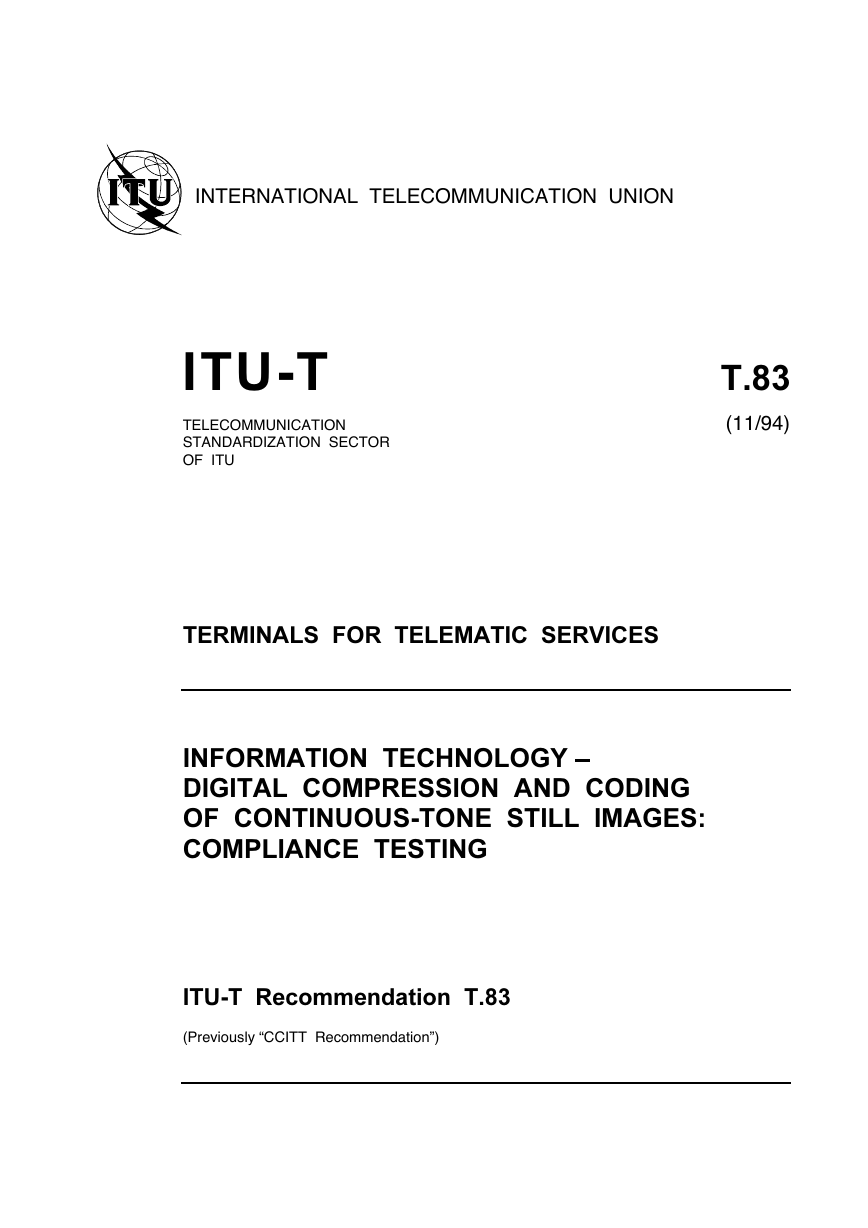
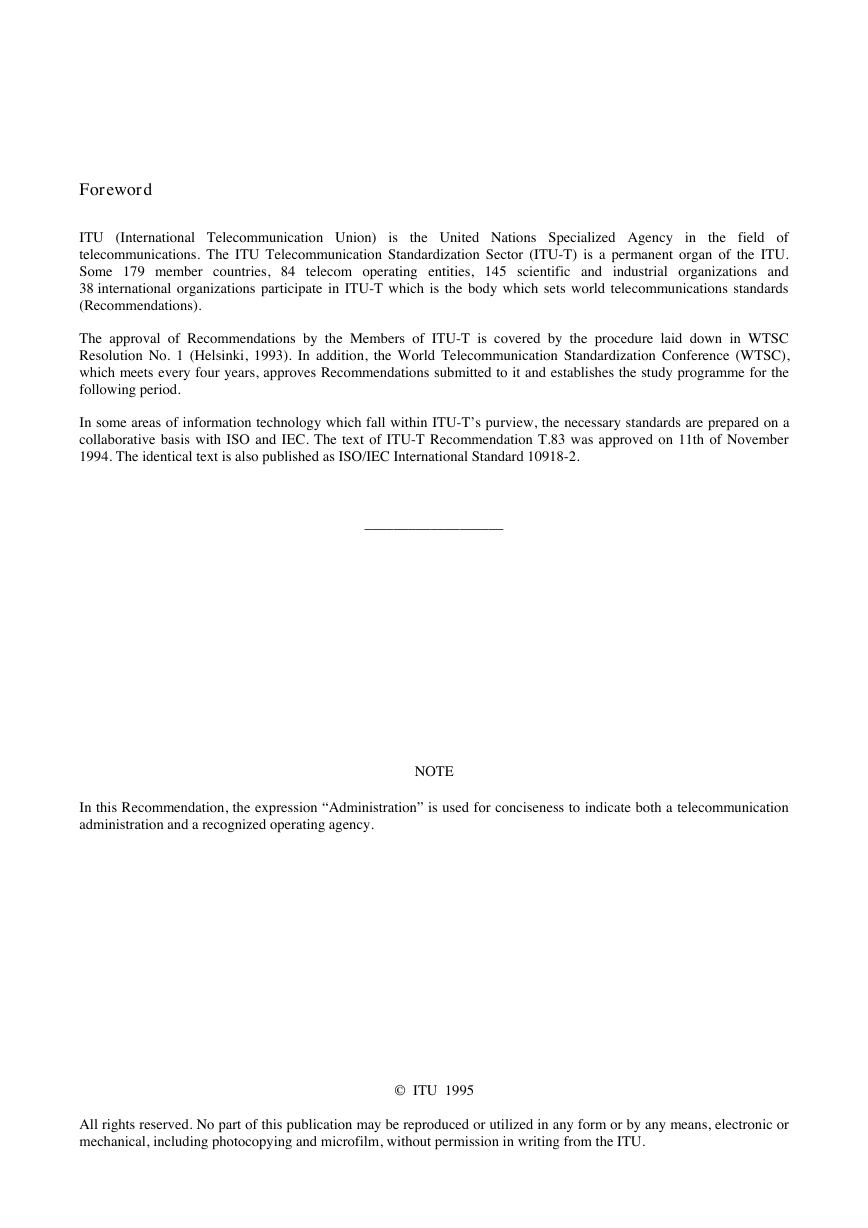

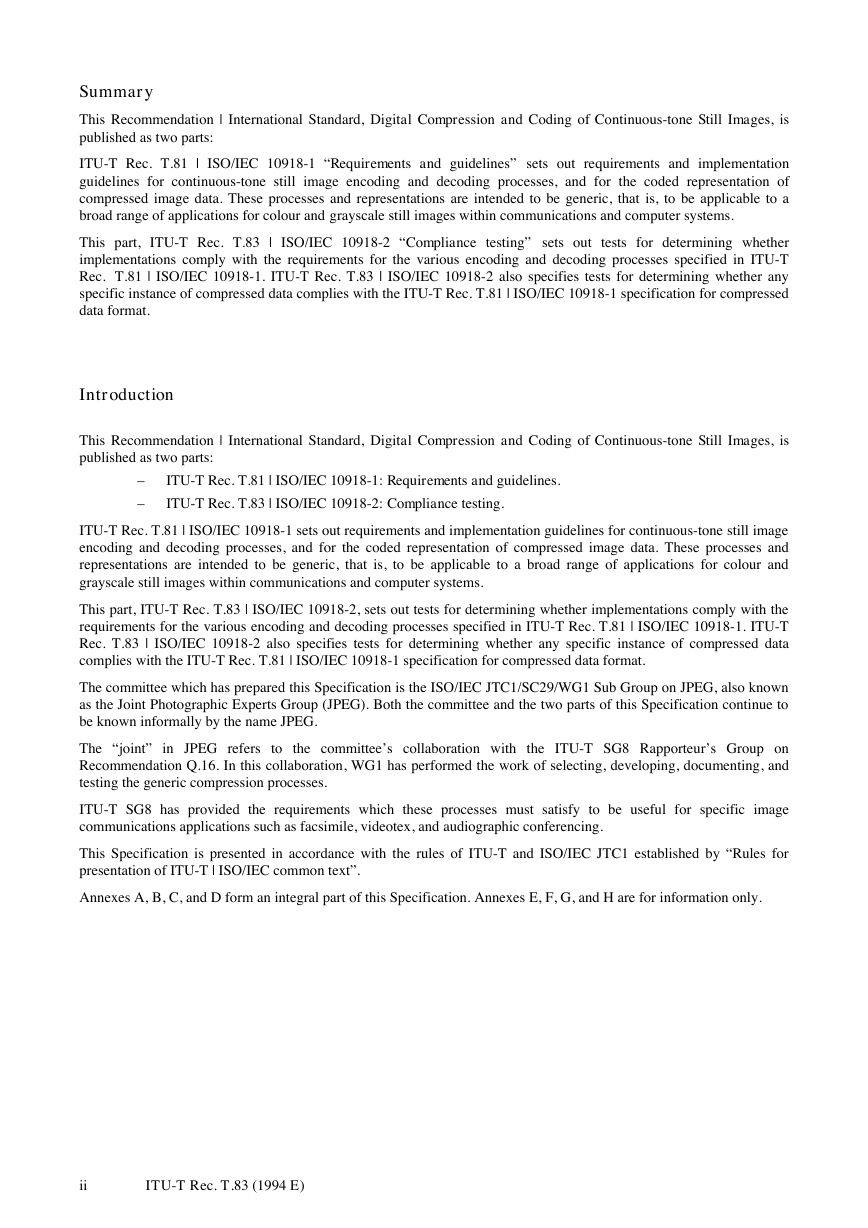
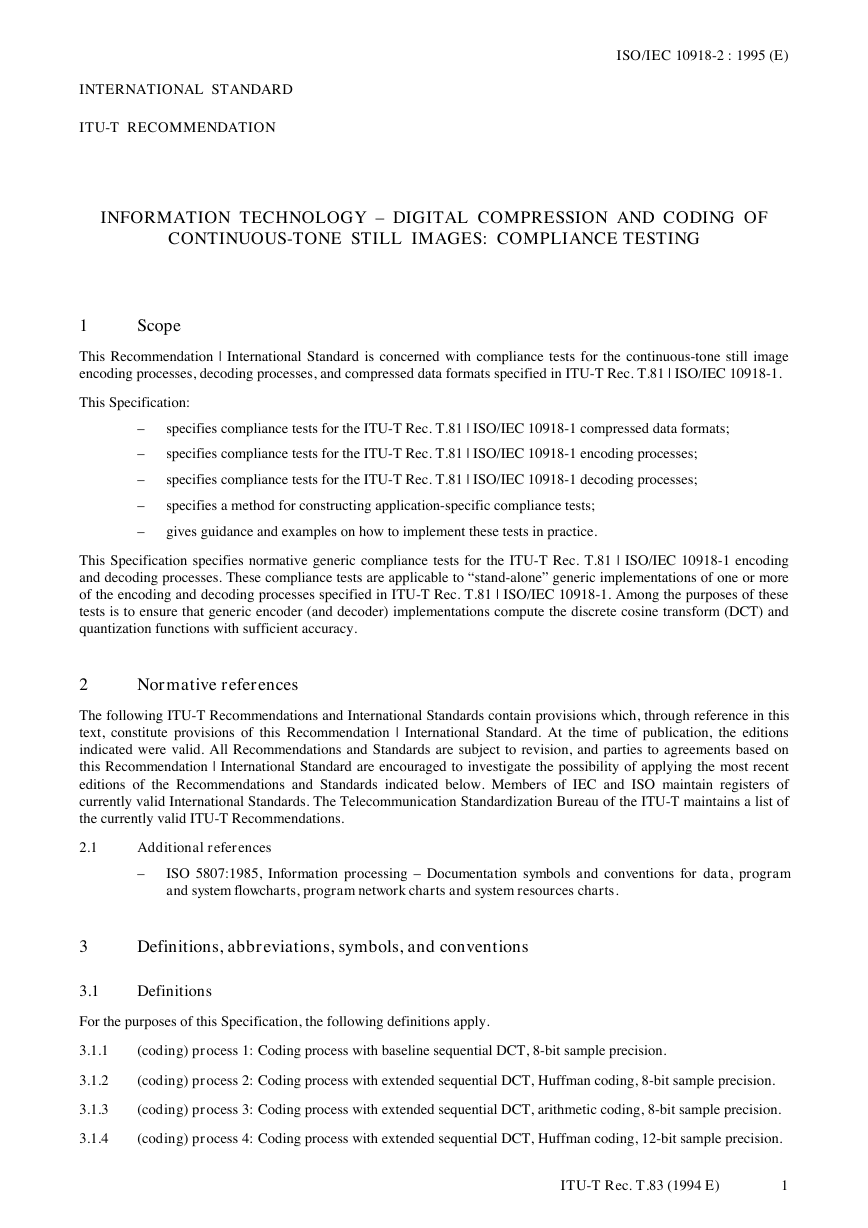
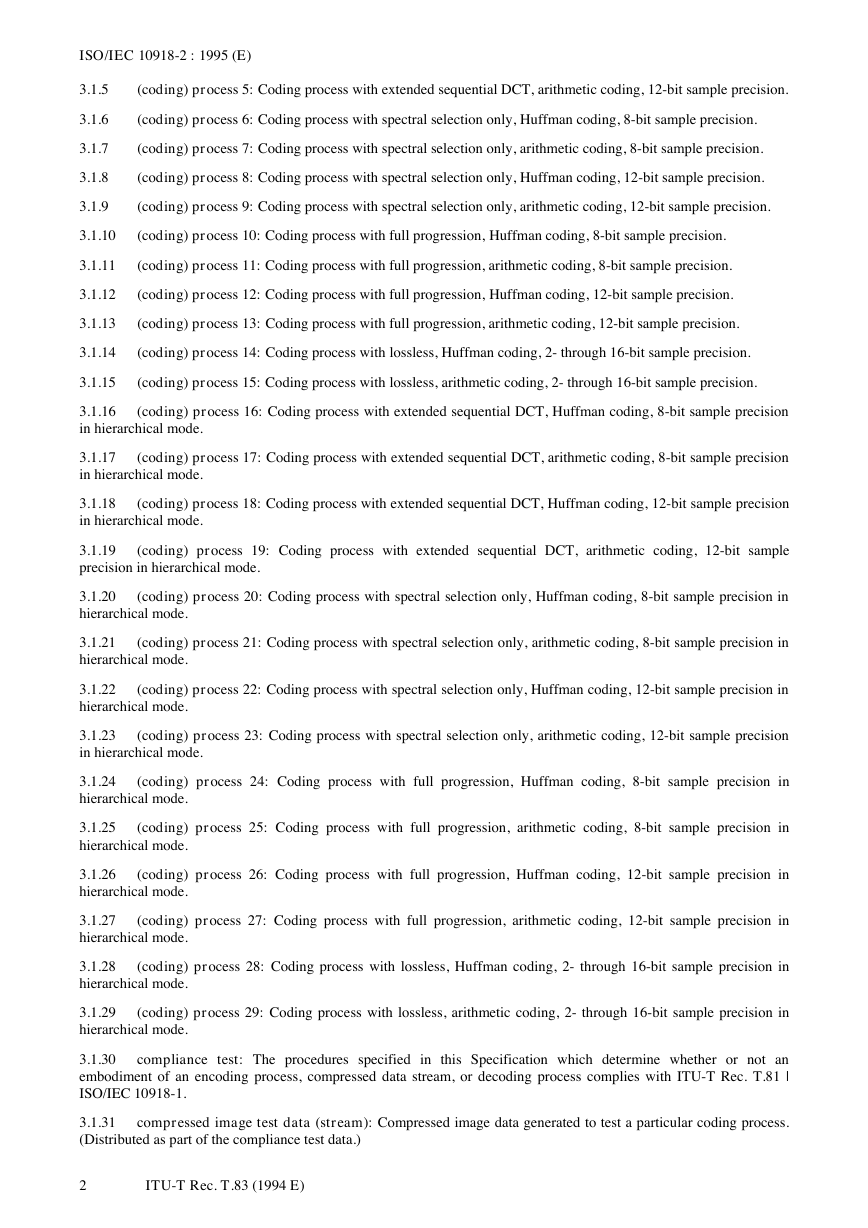
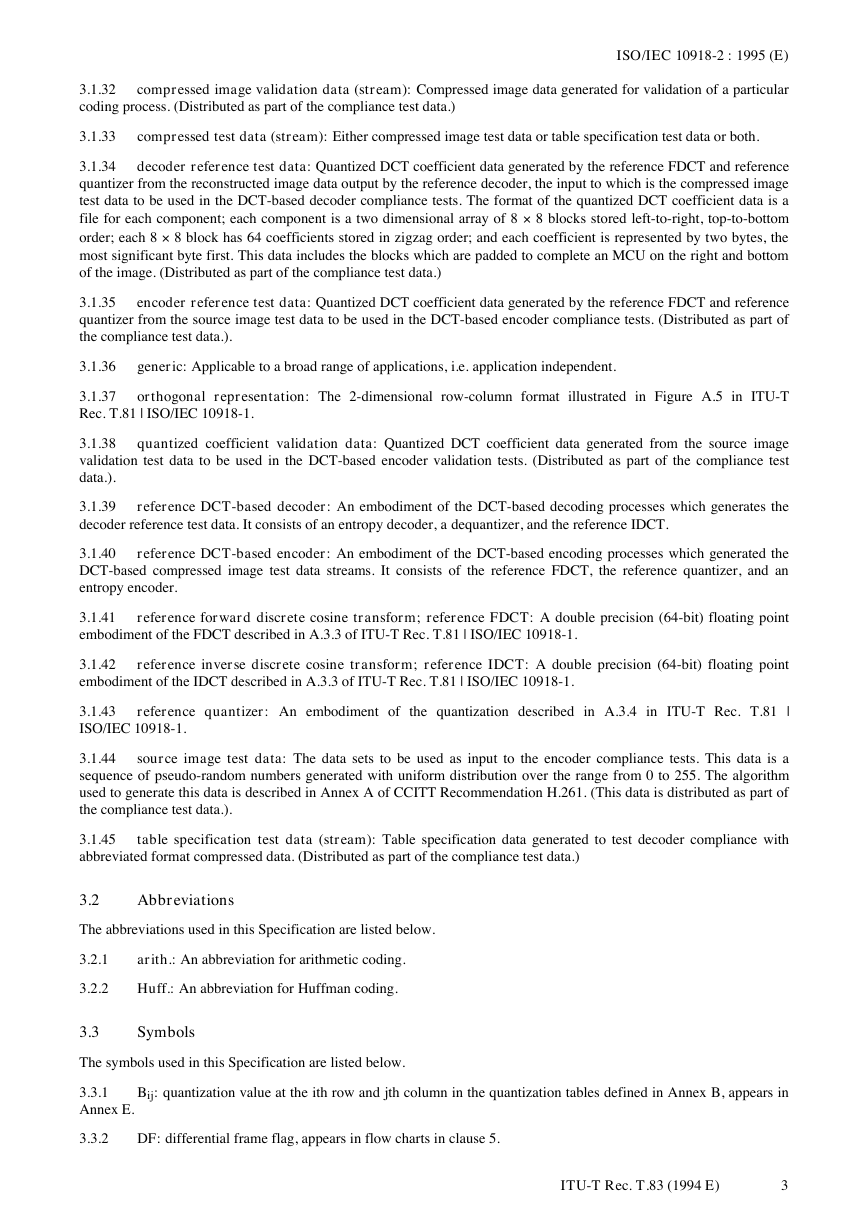









 2023年江西萍乡中考道德与法治真题及答案.doc
2023年江西萍乡中考道德与法治真题及答案.doc 2012年重庆南川中考生物真题及答案.doc
2012年重庆南川中考生物真题及答案.doc 2013年江西师范大学地理学综合及文艺理论基础考研真题.doc
2013年江西师范大学地理学综合及文艺理论基础考研真题.doc 2020年四川甘孜小升初语文真题及答案I卷.doc
2020年四川甘孜小升初语文真题及答案I卷.doc 2020年注册岩土工程师专业基础考试真题及答案.doc
2020年注册岩土工程师专业基础考试真题及答案.doc 2023-2024学年福建省厦门市九年级上学期数学月考试题及答案.doc
2023-2024学年福建省厦门市九年级上学期数学月考试题及答案.doc 2021-2022学年辽宁省沈阳市大东区九年级上学期语文期末试题及答案.doc
2021-2022学年辽宁省沈阳市大东区九年级上学期语文期末试题及答案.doc 2022-2023学年北京东城区初三第一学期物理期末试卷及答案.doc
2022-2023学年北京东城区初三第一学期物理期末试卷及答案.doc 2018上半年江西教师资格初中地理学科知识与教学能力真题及答案.doc
2018上半年江西教师资格初中地理学科知识与教学能力真题及答案.doc 2012年河北国家公务员申论考试真题及答案-省级.doc
2012年河北国家公务员申论考试真题及答案-省级.doc 2020-2021学年江苏省扬州市江都区邵樊片九年级上学期数学第一次质量检测试题及答案.doc
2020-2021学年江苏省扬州市江都区邵樊片九年级上学期数学第一次质量检测试题及答案.doc 2022下半年黑龙江教师资格证中学综合素质真题及答案.doc
2022下半年黑龙江教师资格证中学综合素质真题及答案.doc